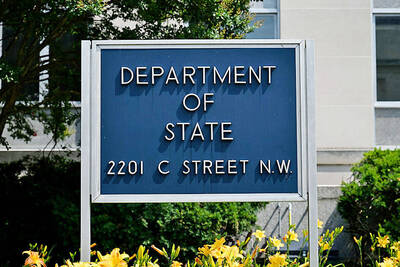Officials yesterday were at a loss to explain a mix-up by Premier Wu Den-yih (吳敦義), who told the legislature on Tuesday that the nation’s three operational nuclear plants were “much safer” than those in Japan because they were “fourth generation” — something both Taiwan Power Co (Taipower) and the Atomic Energy Council (AEC) have said is wrong.
“The Fukushima Dai-ichi [-nuclear power] plant was equipped with a third-generation [reactor], while Taiwan’s nuclear power plants operate fourth--generation ones,” Wu told the legislature, claiming that this alone made Taiwan’s plants safer.
SIMILAR PLANTS
However, as the Taipei Times reported yesterday, fourth--generation reactors are not expected to be commercially viable for another two decades and an investigation has shown that the types of -reactors used at the Japanese plant are very similar to those in Taiwan.
Asked for comment on the discrepancy, a senior Government Information Office official who was not authorized to speak to the media said: “Wu could have made a mistake,” referring further inquiries to the AEC.
For its part, the council said Wu was either misinformed or that information was “lost in translation.”
“Perhaps it is just a misunderstanding. Perhaps the premier was referring to the boiling water reactor types and mistook them for the generation variants,” said Chang Shin (張欣), an official at the council’s Department of Nuclear Regulation.
However, another council official speaking on condition of anonymity was more forthcoming.
The units at the Fukushima Dai-ichi plant, which started running in 1971, use three types of boiling water reactors (BWR). All six reactors are second--generation variants, the officials told the Taipei Times, information that was corroborated by the Japan Atomic Energy Agency.
Similarly, the first two plants in Taiwan — both in New Taipei City (新北市) — use BWR-4 and BWR-6 reactors and are the same second-generation variant as those used at Fukushima, the official said. Taipower also confirmed that no operational nuclear plant in Taiwan uses anything newer than second--generation reactors.
THIRD PLANT
For its part, the third plant, in Pingtung County, uses another second-generation device known as a pressurized water reactor (PWR), considered safer than BWR variants.
The most modern nuclear reactor in Taiwan is found at the Fourth Nuclear Power Plant, still under construction in New Taipei City’s Gongliao District (貢寮), which uses two advanced boiling water reactors. Those are third-generation reactors.
The three operational nuclear plants in Taiwan are therefore no more advanced than the Fukushima Dai-ichi power plant, the council official said.
In fact, all but one of the reactors at the Fukushima plant are either of similar design or more advanced — in the case of reactor six, which is a BWR-5 — than those at Taiwan’s first nuclear plant, the Jinshan Nuclear Power Plant.

A car bomb killed a senior Russian general in southern Moscow yesterday morning, the latest high-profile army figure to be blown up in a blast that came just hours after Russian and Ukrainian delegates held separate talks in Miami on a plan to end the war. Kyiv has not commented on the incident, but Russian investigators said they were probing whether the blast was “linked” to “Ukrainian special forces.” The attack was similar to other assassinations of generals and pro-war figures that have either been claimed, or are widely believed to have been orchestrated, by Ukraine. Russian Lieutenant General Fanil Sarvarov, 56, head

SAFETY FIRST: Double the number of police were deployed at the Taipei Marathon, while other cities released plans to bolster public event safety Authorities across Taiwan have stepped up security measures ahead of Christmas and New Year events, following a knife and smoke bomb attack in Taipei on Friday that left four people dead and 11 injured. In a bid to prevent potential copycat incidents, police deployments have been expanded for large gatherings, transport hubs, and other crowded public spaces, according to official statements from police and city authorities. Taipei Mayor Chiang Wan-an (蔣萬安) said the city has “comprehensively raised security readiness” in crowded areas, increased police deployments with armed officers, and intensified patrols during weekends and nighttime hours. For large-scale events, security checkpoints and explosives

PUBLIC SAFETY: The premier said that security would be tightened in transport hubs, while President Lai commended the public for their bravery The government is to deploy more police, including rapid response units, in crowded public areas to ensure a swift response to any threats, President William Lai (賴清德) said yesterday after a knife attack killed three people and injured 11 in Taipei the previous day. Lai made the remarks following a briefing by the National Police Agency on the progress of the investigation, saying that the attack underscored the importance of cooperation in public security between the central and local governments. The attack unfolded in the early evening on Friday around Taipei Main Station’s M7 exit and later near the Taipei MRT’s Zhongshan

REBUFFED: In response to Chinese criticism over recent arms sales, Washington urged Beijing to engage in meaningful dialogue instead of threats and intimidation Washington’s long-term commitment to Taiwan would not change, the US Department of State said yesterday, urging Beijing to stop pressuring Taiwan and engage in meaningful bilateral dialogues. The remarks came in response to a backlash from Beijing about Washington’s latest approval of arms sales to Taiwan. The US Defense Security Cooperation Agency said in a statement on Wednesday that the Taipei Economic and Cultural Representative Office in the US has asked to purchase an arms package, including Tactical Mission Network Software; AH-1W helicopter spare and repair parts; M109A7 self-propelled howitzers; HIMARS long range precision strike systems; tube-launched, optically tracked, wire-guided missiles; Javelin